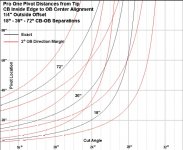Here's a tentative plot of the pivot lengths for three different CB-OB separations against cut angles in the range of about 15-30 degrees (the graph goes from 14 to 34 degrees). There are three curves for each CB-OB distance: a central black one showing the geometrically correct pivot length, surrounded by two red ones indicating the pivot lengths producing +/- 2 degree errors in OB direction.The pivot length needs to be shorter than the CB OB distance. Not a problem for long shots, but it is a problem up close and personal shots.
Someone suggested on one of the CTE threads that this distance should be about 3/4 of the CB OB distance. I have seen recently that it should be 1/2 of the CB OB distance.
The 3/4-ths seems to work for me.

According to this, the only pivot locations that roughly agree with those suggested on the DVD (7"-9" according to Dr. Dave's summary), are for the 18" separation at cut angles within a few degrees of 16. The pivot distances move down the stick (and ultimately beyond it) as the desired cut angles approach 30 degrees. This is because the stick, according to the interpretation of the pre-pivot alignment used here, is oriented parallel to the CTE line prior to pivoting. It thus requires a pivot looking ever more like a parallel shift as the cut angle nears 30 degrees.
I used the term "tentative" because there is considerable ambiguity as to where one's cue should actually be pointing in the descriptions of the method (I don't know if that's been resolved yet). At least in the interval of about 15-30 degrees, the CB edge to OB center (ETC) direction is parallel to the CTE direction. Although they converge in the field of vision, any line running between them so to speak (radiating from the point of convergence), is also parallel to them. Another possible interpretation, however, ala Lamas, is that the pre-pivot direction should run parallel to the ETC in the field of vision (image plane of the eye). If that is what's meant, then that would make it dependent on eye position, orientation of the optic axis, and a few other things, but would tend to squeeze the pivot locations into a tighter range (judging from similar graphs based on center to contact point alignments). Before attempting ones based on that interpretation, perhaps we can get more precise descriptions of this aspect of the method?
Jim